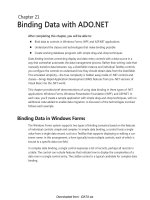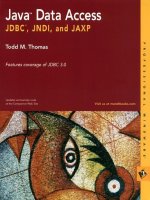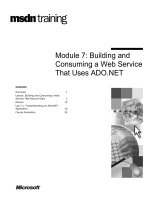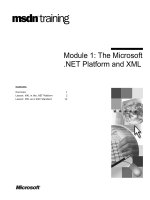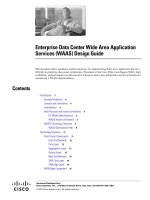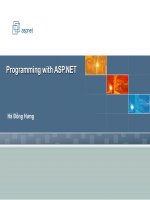Tài liệu Accessing data with ADO.NET ppt
Bạn đang xem bản rút gọn của tài liệu. Xem và tải ngay bản đầy đủ của tài liệu tại đây (399.75 KB, 40 trang )
aspnet
aspnet
Accessing data with ADO.NET
Accessing data with ADO.NET
Hà Đồng Hưng
Objectives
•
Introduction
–
ADO.NET and other technologies
•
Connected Objects
–
Objects List
–
Demonstrations
–
Using Disconnected Objects in VS.NET
•
Disconnected Objects
–
Objects List
–
Demonstrations
–
Using Disconnected objects in VS.NET
Objectives
•
Introduction
–
ADO.NET and other technologies
•
Connected Objects
–
Objects List
–
Demonstrations
–
Using Disconnected Objects in VS.NET
•
Disconnected Objects
–
Objects List
–
Demonstrations
–
Using Disconnected objects in VS.NET
What is ADO.NET ?
•
ADO.NET is a set of libraries included with the Microsoft
.NET Framework that help you communicate with various
data stores from .NET applications
–
connecting to a data source
–
submitting queries
–
processing results
•
Can also use ADO.NET as a hierarchical, disconnected data
cache to work with data offline
Why a new data access technology?
•
Visual Basic 3 - Data Access Objects (DAO)
–
designed to communicate with local file-based databases
•
Visual Basic 4 - Remote Data Objects (RDO)
–
a fast, lightweight data access layer designed to talk to larger server-based
databases (SQL Server, Oracle…)
•
Visual Basic 5 and Visual Studio 97 - ODBCDirect
–
combine the power of RDO with the ease of use that DAO provides
•
Visual Basic 6 and Visual Studio 6 - ADO
–
a data access model we could use easily in server-side scripts (fewer lines
of code, allow us to pass data structures from server to client and back)
Drawbacks of older technologies
•
Problems:
–
Developers need to build more powerful applications
•
work with XML data
•
can pass ADO Recordset objects between different tiers in your
application, but cannot combine the contents of multiple
Recordset objects
•
…
–
Recent versions of ADO added more XML features, but ADO will
never handle XML data as efficiently as ADO.NET)
ADO.NET model
•
ADO.NET is designed to help developers build efficient multi-
tiered database applications across intranets and the Internet
ADO.NET model
•
The disconnected half of the ADO.NET object model do not
communicate directly with the connected objects
•
A major change from previous Microsoft data access object
models.
–
In ADO, Recordset object stores the results of your queries.
–
Call Open method to fetch the results of a query
–
Call Update method to submit changes stored within the Recordset to your
database.
•
ADO.NET DataSet is comparable in functionality to the ADO
Recordset.
–
However, DataSet does not communicate with your database.
–
In order to fetch data from your database into a DataSet, you pass the
DataSet into the Fill method of a connected ADO.NET object—the
DataAdapter.
.NET Data Providers
•
SQL Client .NET Data Provider
–
communicate with SQL Server databases, version 7+
•
OLE DB .NET Data Provider
–
communicate with various data stores through OLE DB providers
•
Each .NET data provider implements the same base classes
–
Base classes: Connection, Command, DataReader, Parameter,
Transaction
–
their actual names depend on the provider
Connection Strings
•
SQL Server
–
Provider=SQLOLEDB;Data Source=MyServer\MyInstance;
Initial Catalog=MyDatabase;User ID=MyUID;Password=MyPass;
–
Provider=SQLOLEDB;Data Source=MyServer;
Initial Catalog=MyDb; Integrated Security=SSPI;
–
Provider=SQLOLEDB;Data Source=MyServer;
Initial Catalog=MyDatabase; Trusted_Connection=Yes;
•
Oracle
–
Provider=MSDAORA;Data Source=MyDatabaseAlias;
User ID=MyUID;Password=MyPass;
•
Access
–
Provider=Microsoft.Jet.OLEDB.4.0;Data Source=C:\A\MyDb.mdb;
–
Provider=Microsoft.Jet.OLEDB.4.0;Data Source=Data\MyDb.mdb;
–
Provider=Microsoft.Jet.OLEDB.4.0;Data Source=C:\A\MyDb.mdb;
Jet OLEDB:Database Password=MyPass;
Objectives
•
Introduction
–
ADO.NET and other technologies
•
Connected Objects
–
Objects List
–
Demonstrations
–
Using Disconnected Objects in VS.NET
•
Disconnected Objects
–
Objects List
–
Demonstrations
–
Using Disconnected objects in VS.NET
Using ADO.NET Objects
Connected Objects
•
Connection Object:
–
Use it to connect to and disconnect from your database.
•
Command Object
–
Represent a query against your database (retrieve, modify…), a call
to a stored procedure, a direct request to return the contents of a
specific table
•
DataReader Object (data read-only)
–
Is designed to help you retrieve and examine the rows returned by
your query quickly
•
Transaction Object
•
Parameter Object
Connected Objects
•
Data Adapter
–
act as a bridge between your database and the disconnected objects
in the ADO.NET object model
–
Fill method fetch the results of a query into a DataSet or a
DataTable
–
Update method submit the cached changes in your DataSet to your
database.
Objectives
•
Introduction
–
ADO.NET and other technologies
•
Connected Objects
–
Objects List
–
Demonstrations
–
Using Disconnected Objects in VS.NET
•
Disconnected Objects
–
Objects List
–
Demonstrations
–
Using Disconnected objects in VS.NET
Connected Objects
Demonstrations
Dim strConn As String = "Provider=Microsoft.Jet.OleDB.4.0; & _
“Data Source=db1.mdb"
Dim cn As New OleDbConnection(strConn)
cn.Open()
...
cn.Close()
•
Open connection
